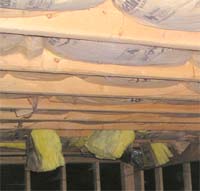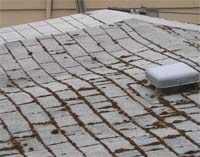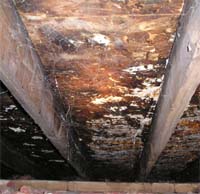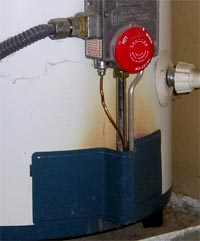A well maintained home will last longer, be a healthier place to live, maximizes the resale value, minimizes repairs costs, provides a more comfortable and safe living space. This article is a useful tool to help you maintain one of your most valuable assets. Set aside 2% or 3% a year of the homes value for the major repair expenses like water heaters, roofs, painting, floors, heating/cooling systems, gutter repairs etc.
Several times a year, during a hard rain, get an umbrella and see how your home and yard fairs in a downpour. Are the gutters working properly? Are the downspouts leaking or disconnected? Are they discharging water in working drains or splash blocks and carrying the water away from the structure? Is there water running towards the home or puddling next to the house? Is the grading of the soil proper to move excess water away from the home? Are there sidewalks or landscaping edging holding water next to the home? These are all major causes of water in crawlspaces and basements. Check basements for leaks and/or if possible, check crawlspaces to assure they are not accumulating excess water. Read more about keeping water out of your home here.
If possible, get into crawlspaces checking for moisture and other problems. This can be a dirty job but is probably the most important inspection you can do. If you are unable or unwilling to do this, I strongly recommend that you hire a professional to do it for you every couple of years or when you suspect a problem. If you detect any unusual odors, musty smells etc, this could indicate leaks in plumbing or water in crawlspaces.
 The insulation in this crawl space is upside down and falling off the joists |
Use a good quality dust mask and a strong flashlight. Take a camera with you so you can document any problems to show contractors what issues you may have. Look for all water lines and drains, carefully check around toilets, tubs and sinks for stains, leaks or rotten wood. Make sure the vapor barrier (plastic sheeting) is complete. There should be no bare earth, wood or paper debris.
Make sure vents are not blocked by landscaping or insulation. Examine the insulation to assure that it is not falling down and installed properly. If you can see a insulation that has a vapor barrier (paper or plastic sheeting) it must be facing the heated side. I can't tell you how many crawlspaces I go in that have the insulation upside down. If there is
duct work, check to see that it is properly connected and insulated. Check the walls for cracks and footings under posts for settlement. Check for any sign of pests (rodents, droppings, ants, termites etc)
Everyone should check the condition of their home, landscaping and retaining walls that affect the structure twice a year. Some of these items include the following:
Caulk and paint. I can't stress enough how important this is. Check the caulking around all doors, windows, trim, and utility holes. Check all windows for broken glass, cracks, broken seals or 'fogging', locking mechanisms and screens Check all doors for proper locks, weather stripping, thresholds and door sweeps. If you can see any daylight around a door you are going to pay for lost heat and in the long run that will pay for the proper
weatherization.
Check the stain or paint on decking surfaces, railings, steps etc., and examine the framing, posts and beams.
Trim all plants away from the building, decks, roofs and power lines.
Check plumbing fixtures and drains. Look for leaks under sinks and in vanities/cabinets.
Note trip hazards on drives, walks and patios. If they are getting worse, try to figure out why. Is the ground under them slipping, sinking or are there tree roots causing the problem? You should consider repairing them before someone trips and gets hurt.
|
|
Clean out gutters and check downspouts. Use extreme caution around overhead electrical wires, ladders and roofs! Do not take any unnecessary chances here please. If you are not comfortable doing this, have a professional do it for you. This is a good time to re-tar any patches on the roof. Tar lasts for a relatively short time and must be re applied regularly to prevent leaks. Check the roof for:
-
Gutter attachments, downspout mounts, splash block placements
-
Fasteners that penetrate the roof, re-apply tar as needed
-
Missing shingles, conditions of valleys and ridges,
flashings, check condition of tar dots on the nails -
Attic and plumbing vents and fasteners. Tar as needed
-
Flashings around chimneys
-
Soft sheeting, roof warping or 'wow' of the roofing planes
|
|
Inspect the attic, looking for :
-
Disconnected exhaust vents, heating
duct work -
Moisture stains, mold/mildew/fungus growths, address excessive moisture
problems promptly -
Broken framing or
delaminated sheeting -
Blocked vents, broken vent screens and any signs of birds or pests
Check all stairs for
-
Good lighting
-
Bouncy or poor framing, loose treads, etc.
-
Hand rails should be solid, easy to grip, proper height (about 32" above stair nose) with no openings greater then 4"
Fireplaces
-
If you have a
wood burning insert, stove or fireplace and use it regularly have the flue examined and cleaned once a year -
Examine the chimney crown and fire brick for excessive cracking
-
Check the flashing and
counterflashing to see they are in good order -
Be sure you have a carbon monoxide detector installed
Furnace/AC
-
Replace filters, if you have one, clean electrostatic air cleaners
-
Oil furnaces should be 'tuned up' by a professional every year or 2
-
Turn off the power and vacuum electric wall heaters, the dust
buildup can cause sparks and burning debris to be ejected upon start up -
Check A/C hose insulation. Keep landscaping and debris away from exterior heat pumps and A/C compressors
Laundry
-
Look behind dryers and check for lint accumulation or kinked/crushed vent hoses. Repair or replace as needed
-
Outside vents, clean lint accumulations
-
Check washing machine hoses, some manufacturers recommend replacing them every few years.
|
|
Hot water heaters
-
Look for leaks at the supply lines, shutoff valves, over
pressure/temperature valves -
If in an unheated space, insulating the tank will save you money
-
If a gas unit, check for exhaust
rollout stains and earthquake straps. See the photo to the left -
Smell around the gas supply lines and thermostat to check for leaks.
Electrical checks
-
Check power cords
-
Extension cords, discard/properly repair any that are worn of have broken insulation
-
Test all GFCIs and if your electrical panel has them arc fault interrupters. These fail regularly and are very important safety devices
-
If any breakers or fuses need regular resetting/replacement, have a electrician check them out
Smoke and CO Detectors
Check all smoke detectors, replacing batteries regularly. Most homes have smoke detectors but many have batteries that are dead. If you have an attached garage or any appliances, furnaces, fireplaces etc. that use natural gas, oil, wood, kerosene or any combustible material, please get a carbon monoxide detector. They are not the same thing as a smoke detector! Some units are combo smoke and CO detectors, but not usually. We can usually smell smoke but there is often no way to detect carbon monoxide until a hazardous condition exists in the home. Read an article we wrote about carbon monoxide hazards here

If you find this information useful, don't keep us a secret!
List us on any of your favorite networking / bookmarking sites






